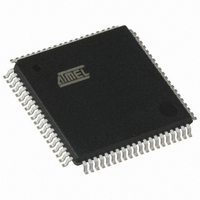AT80C51SND1C-ROTIL Atmel, AT80C51SND1C-ROTIL Datasheet - Page 179

AT80C51SND1C-ROTIL
Manufacturer Part Number
AT80C51SND1C-ROTIL
Description
IC MCU FLASH MP3 DECODER 80-TQFP
Manufacturer
Atmel
Series
80Cr
Datasheet
1.AT80C51SND1C-ROTIL.pdf
(213 pages)
Specifications of AT80C51SND1C-ROTIL
Core Processor
8051
Core Size
8-Bit
Speed
40MHz
Connectivity
I²C, IDE/ATAPI, MMC, SPI, UART/USART, USB
Peripherals
Audio, I²S, MP3, PCM, POR, WDT
Number Of I /o
44
Program Memory Type
ROMless
Ram Size
2.25K x 8
Voltage - Supply (vcc/vdd)
2.7 V ~ 3.3 V
Data Converters
A/D 2x10b
Oscillator Type
Internal
Operating Temperature
-40°C ~ 85°C
Package / Case
80-TQFP, 80-VQFP
Lead Free Status / RoHS Status
Contains lead / RoHS non-compliant
Eeprom Size
-
Program Memory Size
-
Other names
AT80C51SND1CROTIL
Available stocks
Company
Part Number
Manufacturer
Quantity
Price
- Current page: 179 of 213
- Download datasheet (3Mb)
22. Keyboard Interface
22.1
22.1.1
22.2
4109L–8051–02/08
Description
Registers
Power Reduction Mode
The AT8xC51SND1C implement a keyboard interface allowing the connection of a 4 x n matrix
keyboard. It is based on 4 inputs with programmable interrupt capability on both high or low
level. These inputs are available as alternate function of P1.3:0 and allow exit from idle and
power down modes.
The keyboard interfaces with the C51 core through 2 special function registers: KBCON, the
keyboard control register (see Table 152); and KBSTA, the keyboard control and status register
(see Table 153).
The keyboard inputs are considered as 4 independent interrupt sources sharing the same inter-
rupt vector. An interrupt enable bit (EKB in IEN1 register) allows global enable or disable of the
keyboard interrupt (see Figure 22-1). As detailed in Figure 22-2 each keyboard input has the
capability to detect a programmable level according to KINL3:0 bit value in KBCON register.
Level detection is then reported in interrupt flags KINF3:0 in KBSTA register.
A keyboard interrupt is requested each time one of the four flags is set, i.e. the input level
matches the programmed one. Each of these four flags can be masked by software using
KINM3:0 bits in KBCON register and is cleared by reading KBSTA register.
This structure allows keyboard arrangement from 1 by n to 4 by n matrix and allow usage of KIN
inputs for any other purposes.
Figure 22-1. Keyboard Interface Block Diagram
Figure 22-2. Keyboard Input Circuitry
KIN3:0 inputs allow exit from idle and power-down modes as detailed in section “Power Man-
agement”, page 48. To enable this feature, KPDE bit in KBSTA register must be set to logic 1.
Due to the asynchronous keypad detection in power down mode (all clocks are stopped), exit
may happen on parasitic key press. In this case, no key is detected and software must enter
power down again.
Table 152. KBCON Register
KIN3:0
KIN0
KIN1
KIN2
KIN3
Input Circuitry
Input Circuitry
Input Circuitry
Input Circuitry
KBCON.7:4
KINL3:0
0
1
KBSTA.3:0
KINF3:0
AT8xC51SND1C
IEN1.4
EKB
KBCON.3:0
KINM3:0
Keyboard Interface
Interrupt Request
179
Related parts for AT80C51SND1C-ROTIL
Image
Part Number
Description
Manufacturer
Datasheet
Request
R

Part Number:
Description:
DEV KIT FOR AVR/AVR32
Manufacturer:
Atmel
Datasheet:

Part Number:
Description:
INTERVAL AND WIPE/WASH WIPER CONTROL IC WITH DELAY
Manufacturer:
ATMEL Corporation
Datasheet:

Part Number:
Description:
Low-Voltage Voice-Switched IC for Hands-Free Operation
Manufacturer:
ATMEL Corporation
Datasheet:

Part Number:
Description:
MONOLITHIC INTEGRATED FEATUREPHONE CIRCUIT
Manufacturer:
ATMEL Corporation
Datasheet:

Part Number:
Description:
AM-FM Receiver IC U4255BM-M
Manufacturer:
ATMEL Corporation
Datasheet:

Part Number:
Description:
Monolithic Integrated Feature Phone Circuit
Manufacturer:
ATMEL Corporation
Datasheet:

Part Number:
Description:
Multistandard Video-IF and Quasi Parallel Sound Processing
Manufacturer:
ATMEL Corporation
Datasheet:

Part Number:
Description:
High-performance EE PLD
Manufacturer:
ATMEL Corporation
Datasheet:

Part Number:
Description:
8-bit Flash Microcontroller
Manufacturer:
ATMEL Corporation
Datasheet:

Part Number:
Description:
2-Wire Serial EEPROM
Manufacturer:
ATMEL Corporation
Datasheet:











